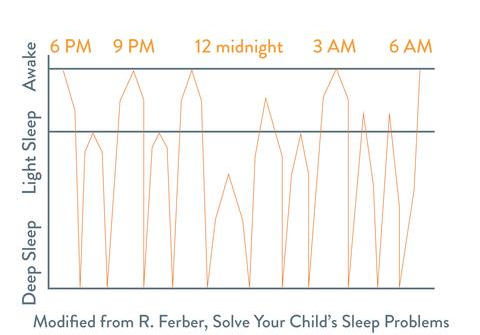As if maintaining the perfect bedtime routine was not enough, as a new parent, you are also expected to master your baby's nap-time schedule. To complicate matters further, a better daytime feeding, playing and napping routine usually defines how well the baby sleeps at nighttime and vice versa. It's a vicious circle.
Then there are baby's growth spurts or a sudden onset of GERD or colic or plain old infant gas that could throw a well established nap schedules off. So when your baby’s nap or sleep time schedule is off, finding the cause is like solving a suspenseful case of whodunit!
So lets start with a basic understanding of infant sleep at nap time, and then look at some possible schedules by age range. We will address some common questions parents ask on infant nap time schedules.
In this post we will cover the following:
1) Is There A Standard Nap Time Duration By Age?
2) How Do I Know If My Baby Is Getting Enough Sleep During Each Nap?
3) Your Baby's Sleepiness Cues
4) How To Soothe An Overtired Baby
5) How To Develop a Consistent Nap Time Routine
6) A Suggested Nap Time And Sleep Schedule
7) Could Late Bedtime Be Impacting Nap Time Schedule?
8) Helping Your Baby Sleep Through Mid-Sleep Arousals
9) Can My Baby Be Napping Too Much?
Is There A Standard Nap Time Duration By Age?
I wish the answer was a simple yes or no. After poring over much documented material, we found that there is really no set time that infants sleep for, from 0 - 3 months. Just like adults, each infant's need for sleep differs.
All articles give a range, where the lower limit is a ridiculously low number; so low that it may seem that you will spend more time putting your baby to sleep than your baby will spend napping.
While the higher end of that range is so high that you may wonder, "Who are these babies that sleep so well and how lucky are their parents?" and more pressingly, "What could I be doing wrong?"
My guess is most of you are doing nothing wrong…other than holding yourself, and your baby, to some unrealistic standards.
How Do I Know If My Baby Is Getting Enough Sleep During Each Nap?
Taking a scientific approach, if your baby completes at least one full sleep-cycle, then your baby has taken the shortest possible full nap, right? So what is one full sleep cycle? Well, a baby's sleep cycle is not the same as a grown adults.
Your Sleep Cycle:

Your Baby's Sleep Cycle:

Most newborns cycle between deep sleep and short sleep every 10 - 30 minutes. This cycle lengthens with age. By the time your baby is 3 - 4 months old, a single sleep cycle may last about 45 - 50 minutes.
So for a newborn, a 10 - 30 minute nap is a successful and restful sleep. The same can be said for a 3 - 4 month old who naps for 45 - 50 minutes. Longer naps just mean a better and longer sleep.
Now that we have established the shortest duration of sleep, we ask the big question: How do we make it happen?
The trick to helping your baby sleep easier and longer lies in the C-A-C: Cues, Ambiance and Consistency.
Your Baby's Sleepiness Cues

In the first 3 months, babies don't follow a set schedule for sleep. That is why we need to learn to read their tiredness signs, or "Cues". By 3 - 4 months of age, a sleep pattern will emerge and you will get better at reading their cues.
At any age you want to watch for over-tiredness. A common myth that the longer you keep them awake during the day, the better they sleep during the night is like suggesting that if you starve them during the day they eat better at night. Unthinkable right?
Sleep is just like that. In fact, babies that are overtired will take a lot longer to fall asleep. So keep watching for their tiredness cues. Here are some of these cues, some more subtle than others:
Yawning: The easiest way to tell you baby is sleepy is if your baby yawns.
Rubbing Eyes, Ear or Head: Consistently scratching the ear or rubbing the head or eyes is a common sign of sleepiness.
Looking Away: Your baby may not hold your gaze and may look away.
Jerkiness or Fussiness: An overtired baby also gets fussy. The cry may vary from a soft whimper to harsh shrill, depending on how tired the baby is. Listening for cues earlier in the process will help preventing them from getting to this dangerous point. Once crossed this point your baby may take a lot longer to sleep making it a painful experience for both you and him.
Signs of Overtiredness: An overtired baby may cry a shrill cry. His arms may be stretched and body stiff while crying. Such a baby may be too hard to console or soothe.
How To Soothe An Overtired Baby

So what happens when you are unable to catch these cues? Or an unplanned event such as an ill-timed doctor's visit, a visit to the store or over stimulation disrupts your baby's nap schedule?
It is best to take an overtired baby to a quiet place, away from the environment that triggered the response. Even if you are away from the perfect ambiance of your nursery.
Trying to soothe your baby in a busy, stimulating atmosphere will only exacerbate their exhausted state. Rely on pacifiers or a security blanket if possible.
You may be tired as well. If possible, try giving your baby to a family member who is calmer than you. Your tiredness will rub off on the baby. If you are calm, they are calm.
How To Develop a Consistent Nap Time Routine
Inconsistency is the number one cause of short naps and an erratic sleep routine. So now that you have learnt their signs of sleepiness, lets see how we can develop a consistent routine.
I say a consistent routine, rather than a schedule, because "schedule" suggests having a set time, while "routine" suggests having consistent activities that lead to nap time which then develops a more predictable schedule.
Once your baby has reached 4 - 6 weeks some level of consistency will emerge in his or her sleep pattern. Your baby's naps will consolidate into fewer but longer naps instead of the short bursts that your newborn would take.
A consistent sleep environment plays an important role in developing this routine and associated schedule.
To create a perfect environment, wind down activities as soon as you detect the signs of sleepiness as described above. Take the baby into his or her own room. Turn down the lights, draw the curtains, turn up the white noise and swaddle before singing or shushing your baby to sleep. For one of the naps the routine may also include bathing before nursing/feeding/suckling, swaddling and shushing.
I strongly recommend adding white noise to your baby's sleep environment as a positive sleep association.
What is white noise?
Technically white noise is a sound produced by combining different frequencies with equal intensities together. White noise may be technically produced and may sound like a hum, a drone, a radio station on static, a fan, washing machine or even the sound of rain among others. Why do babies love white noise? Well they have spent 9 months in mother’s womb, a place not known to be quiet. In fact it is deafeningly loud in there.
What is sleep drive?
A consistent sleep routine helps build the sleep drive (or sleep pressure). By the 3rd month, your baby needs enough sleep drive to sleep long hours and the full length of the daytime nap. An erratic sleep schedule can disrupt the sleep drive leading to short and generally sucky naps. As a result you may not receive the nice chunk of time you could get to catch up on your chores or take a sweet nap yourself.
A Suggested Nap Time And Sleep Schedule

Newborns typically cycle between feeding, playing and sleeping; in some cases just feeding and sleeping cycles. Once your baby reaches 3 - 4 months of age you will see more of a pattern emerge where your baby's sleep will consolidate into 3 naps during the day.
At 5 - 6 months, your baby will take 2 naps per day which will last till 18 months, which is when your baby will only take one long nap during the day.
After their first feed, newborns like to spend some time being active in the early morning. This is a great time to engage with them, talk to them, massage them and play with them for about 30 - 40 minutes.
After this early morning activity, they would like their second feed and then their first daytime nap. As the day progresses they may alternate between eating and playing or eating and napping. So let him or her follow this cycle as frequently as they need to. Typically a new born will nap 3 to 5 times in one day.
Baby's Nap Time Schedule From 0 to 6 weeks
Number of Naps: 3 - 5 naps
Nap-time Sleep Duration: 15 minutes - 3 hours
Bedtime: Between 9:30 PM - 11:00 PM
Nighttime Sleep Duration: Waking up every 2.5 - 3.5 hours for a feed
Newborns are noisy sleepers. Your baby may move and make sounds during sleep. She may also shudder, which is a result of a still developing nervous system. Read this article on moro reflex and how swaddling can help sleep through it.
Baby's Nap Time Schedule From 6 weeks to 3 months
Number of Naps: 3 - 4 naps
Nap-time Sleep Duration: 30 minutes - 3 hours
Bedtime: Between 08:00 PM - 10:00 PM
Nighttime Sleep Duration: Waking up every 2.5 - 3.5 hours for a feed
Changes in Your Baby: Your baby takes 3 - 4 naps in the day with reasonably consistent durations. Once in the morning, twice during the afternoon, often a short nap during the evening around 5 - 6 PM before getting ready for bedtime around 8:30 - 9PM.
How Should You Prepare: As your baby approaches their third month, it is a good time to institute nap-time and bedtime rituals. Include bath time, massage, cuddling, swaddling, shushing, white noise or reading as a part of a bedtime routine. Moro reflex may still be prevalent and you should try swaddling to help your baby sleep through it.
Baby's Nap Time Schedule From 3 to 6 months
Number of Naps: 3 naps
Nap-time Sleep Duration: 1 - 3 hours
Bedtime: Between 08:00 PM - 10:00 PM
Nighttime Sleep Duration: 9 -12 hours
Changes in Your Baby: Your baby has learned certain associations and may cry for you and want you to hold her during bedtime and nap-time. By now some babies start to sleep through the night. She may also start to roll over at around 4 - 5 months.
How Should You Prepare: During these months, do your best to keep the same consistent sleep routine that you started with in previous months. Try to provide a sleep time at the same times throughout the day. This builds the sleep drive which makes up for nice long naps during the day and night.
To the best possible, avoid sleep associations such as always nursing to sleep. Such associations are harder and harder to break as your baby grows. Once your baby starts rolling over, it is time to stop swaddling. Like any transition you need to help her through. Read this article on making this swaddle transition smoother for her.
Baby's Nap Time Schedule From 6 to 12 months
Number of Naps: 2-3 naps
Nap-time Sleep Duration: 1 - 2 hours
Bedtime: Between 07:00 PM - 8:00 PM
Nighttime Sleep Duration: 10 -12 hours
Changes in Your Baby: Your baby is now moving from 3 naps to 2 solid naps during the day. A short one in the morning around 9 – 10 for 45-60 minutes and another longer one in the afternoon. Your interactive baby now is easily stimulated. She is also turing and may find it hard to settle in one position during this transition.
How Should You Prepare: Consistency, a quiet sleep routine and environment is more important than ever for your interactive baby who want to party with you instead of sleep. Avoid stimulating your baby before naptime or bed time. If your baby wakes herself up as she finds it hard to settle on her back or belly, give her an external sleep association, such as a lovie or a sleep buddy, so that she self soothes instead of waking up looking for you to settle her back to sleep. The Zen Sack's gentle weight, that can be applied on her back or belly, can also help soothe during the trying time.
Baby's Nap Time Schedule From 1 to 1.5 years
Number of Naps: 1 - 2 naps
Nap-time Sleep Duration: Up to 3 hours
Bedtime: Between 07:00 PM - 9:00 PM
Nighttime Sleep Duration: 10 -12 hours
Changes in Your Baby: Your baby may only take one nap.
How Should You Prepare: Like any transition, know that before you know it, your baby will adjust to the new routine. Keep him active and stimulated during the daytime. This will allow him to take a nice long mid day nap. Maintain a consistent nap-time and bedtime routine.
Could Late Bedtime Be Impacting Nap Time Schedule?
Bedtime: It all starts here. When your baby is still less than 2.5 months old, they may be feeding every 2.5 - 3 hours and napping thought the day. Their bedtime may be late, around 9 -10 PM.
By the time your baby is around 2.5 months of age and they have given up the late evening nap, the bedtime should be moved earlier at around 7PM - 8PM. As counter-intuitive as it may sound, putting your baby to sleep late could lead to shorter sleep time.
However starting the bedtime ritual as early as 7PM will help putting your baby to sleep by 8PM and keep them sleeping through the night for long stretches leading to a full night’s sleep. Hooray!
Helping Your Baby Sleep Through Mid-Sleep Arousals
Babies are also known to wake up mid nap. You can lengthen the duration of their nap by simply helping them back to sleep by placing a hand on their chest or patting softly.Creating any other associations such as nursing is not advisable as these habits are very hard to break.
The Zen Swaddle or Zen Sack may help here. These accessories have lightly weighted parts to mimic your touch and help your baby enter a self-soothing cycle.

Can My Baby Be Napping Too Much?
Believe it or not, but there is such a thing as too much napping. If you notice that your baby won't fall asleep by 8PM, check your baby’s daytime cycles against the chart given above. There is a chance that you baby may be getting too much sleep during the day.
Get your baby checked by your pediatrician if any abnormal signs of sleep issues arise and once again, be a stickler for consistency as your baby matures in their sleep patterns.
It is a hard road. Stick around, it will get better. Learn your baby’s cues and respect their need for quiet time and consistent routines and you will raise a healthy napper and a sound sleeper.
The Zen Swaddle and Zen Sack help institute healthy habits early. Don’t create crutches for sleep associations. Many moms wont give their baby a pacifier but will nurse their baby to sleep.
Create associations that can be easily removed from the environment. Its easier to remove a pacifier than to wean them off the habit of being nursed to sleep. Good luck and check back for other tips and tricks to help you during your parenting journey.
To read more articles here are some of our favorite references on infant naptime soothing:
Monumental Guide to Short Naps (Precious Little Sleep)
Daytime sleep tips (Mayo Clinic)

